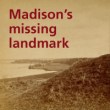 Zane Williams’s Double Take: A Rephotographic Survey of Madison, Wisconsin (2002) not only looks great on a coffee table, it shows how Madison buildings and street scenes changed over half a century. On each left-facing page we see large-format views by Angus McVicar, a commercial photographer, photographed between the mid-1920s and mid-1950s. On right-facing pages, Williams meticulously reproduces the same views in the late 1990s and early 2000s.
Zane Williams’s Double Take: A Rephotographic Survey of Madison, Wisconsin (2002) not only looks great on a coffee table, it shows how Madison buildings and street scenes changed over half a century. On each left-facing page we see large-format views by Angus McVicar, a commercial photographer, photographed between the mid-1920s and mid-1950s. On right-facing pages, Williams meticulously reproduces the same views in the late 1990s and early 2000s.
McVicar shot “Park St. from Viaduct” in 1934 for a Capital Times story on the Greenbush neighborhood’s newly paved Park and Regent streets. Williams rephotographed McVicar’s view in 1998, and returned in 2000 after construction of a new underpass and viaduct. The camera location is now on the southwest bike path. The main difference from 2000 is UW’s 21 N. Park building, which houses the welcome center.











